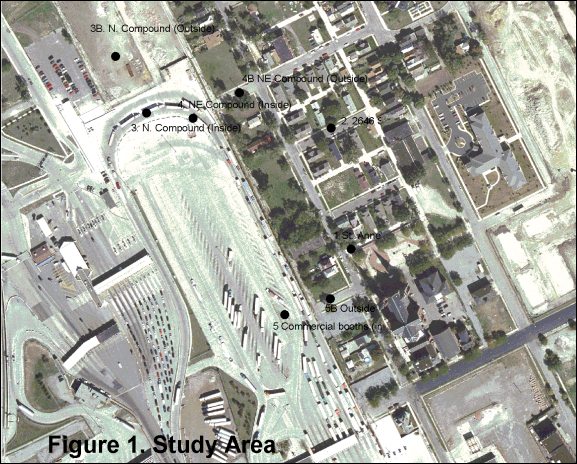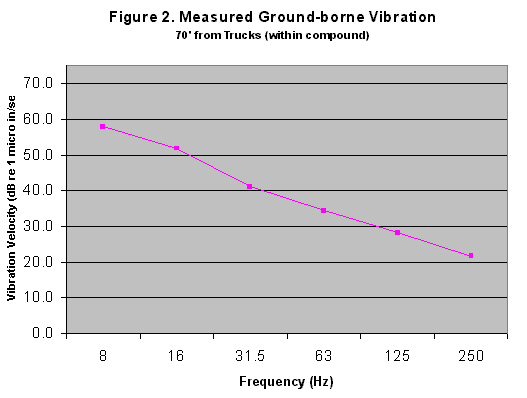
The Ambassador Bridge, located in Detroit, carries truck traffic between the US and Canada and is one of the largest customs inspection facilities in the US. The customs compound through which trucks pass is shown in Figure 1.

Figure 1. Study Area
As can be seen from Figure 1, residential areas are immediately adjacent to the compound. Efforts are underway to expand the facility, and the community was concerned about the possibility of increased noise and vibration from trucks.
DCC measured noise and vibration within the compound (to determine source levels) and outside the compound to determine whether or not noise and vibration levels exceeded relevant standards.
Noise and/or vibration measurements were conducted at 11 sites and a total of 300 octave-band (8 Hz to 16 kHz) frequency spectra were collected. Ten measurement sites were selected to be representative of residential locations and/or to determine the effectiveness of the sound wall. Vibration measurements were collected at two of the noise measurement sites and the 11th site was selected only for vibration measurements.
Noise Measurements
Table 1 shows the results of the noise measurements. Table 1 includes the site location, the date and time of the monitoring, noise level, and the 95% confidence interval (CI), as well as notes about the noise environment at each site.
Table 1. Noise Measurement Results
|
Noise measurements are expressed in terms of Leq (Level Equivalent-20 minute samples). DCC calculated the 95% CI for the 20-minute samples. If the CI is less than 3 decibels (dB), then the 20-minute sample was adequate to characterize an entire hour. As can be seen from Table 1, noise levels are fairly steady in the study area resulting in CI values substantially less than 3 dB. Therefore, a measurement period of less than 20 minutes would have been an adequate sample size in this case.
Noise levels in the community adjacent to the compound ranged from 56 dBA to 64 dBA 1. The highest measured noise level at St. Anne's church was 64 dBA. However, during that particular noise measurement, wind speeds were as high as 25 mph and contributed to the elevated noise levels. At such high wind speeds, noise measurements are not representative of normal conditions since wind turbulence and microphone self-noise mask the normal environmental noise. Therefore, under normal conditions, noise levels at the St. Anne's Church and residential neighborhood ranged from 56 dBA to 63 dBA. An accelerating car with a defective muffler caused the highest value (63 dBA) on St. Anne's Street. Truck noise from the compound was audible at times at all measurement locations; however, within the residential areas, other noise sources such as vehicles on local streets were often the dominant noise source.
The Environmental Protection Agency (EPA) 2 provides descriptions of various environmental noise categories as shown in Table 2.
Table 2. Environmental Noise Categories
|
The daytime Leq approximates DNL when nighttime noise levels are 10 dB lower than daytime levels.
The noise measurements indicate that the noise levels in the study area are within the typical range for the Urban Residential noise category.
Noise Impact Criterion
Various state and federal agencies employ noise impact criteria by which to judge the severity of noise in environmental noise situations. For example, the Federal Highway Administration (FHWA) uses Noise Abatement Criteria (NAC) on new highway construction projects. FHWA's NAC are shown in Table 3. However, FHWA employs rigorous 'feasibility and reasonableness' criteria to sound wall projects. Consequently, highways are sometimes built that result in noise levels exceeding the NAC but no sound walls are constructed.
Table 3. Federal Highway Administration Noise Abatement Criteria
|
In 1993, FHWA provided further definition of the NAC to effectively change the residential threshold value from 67 to 66 dBA. 3
Although the truck inspection station and parking expansion project does not fall under FHWA jurisdiction, the noise measurements in Table 1 are all below 66 dBA, and therefore would not require mitigation according to the FHWA.
Vibration Measurements
Ground-borne vibration was measured at three locations:
- At Site 5, located within the compound about 70' from truck activity.
- At Site 8, located at a residential building (St. Anne's Street), very close to the compound.
- At Site 1, located at St. Anne's Church.

The measured vibration levels shown in Figure 2 are substantially below the human perception level of 65 VdB 4. The measured levels are even further below annoyance levels of 72 VdB and 80 VdB5.
A commonly accepted architectural damage threshold value is 0.2 in/sec or 106 VdB. Architectural damage is defined as being cosmetic in nature, characterized by fine plaster cracking and the re-opening of old cracks. Structural damage is defined as serious plaster cracking and breakage of glass and generally is taken as beginning to occur above vibration velocities of 2 in./sec or 126 VdB. These structural damage thresholds are substantially higher than annoyance and perception thresholds, so the data in Figure 2 are well below building damage thresholds.
The data shown in Figure 2 are typical for background vibration levels (i.e., no immediate source of vibration) and are similar to the data measured at Site 8 and Site 1. This result is not surprising since trucks generally do not impart much vibration into the ground due to their smooth rubber wheels on a smooth surface.
However, trucks can produce more ground-borne vibration if traveling at a sufficient speed over a very rough surface, which is not the case at the compound.
In addition, low-frequency airborne noise from idling trucks in the compound is at moderate levels. Rattling of items such as dishes can occur when low-frequency sound levels are in the 75 to 90 dB range. It is unlikely that buildings adjacent to the compound are being excited by such airborne noise. In addition, complaints of vibration are not consistent with low-frequency airborne noise excitation.
Conclusions
Measured noise levels in the community adjacent to the trucking facility range from 56 dBA to 63 dBA. Although truck noise emanating from the compound is audible at times, so are other noise sources in the area such as local traffic and aircraft and other ambient noise sources. This range of noise levels is typical of urban residential areas according to the EPA. Measured noise levels are also lower than Federal Highway Administrations Noise Abatement Criterion of 66 dBA. Consequently, although the truck noise is sometimes audible, FHWA generally would not consider further mitigation under such conditions.
Measured vibration levels, near trucks in the inspection area as well as a building close to the inspection area and at St. Anne's church, are lower than human perception vibration thresholds. Consequently, it is extremely unlikely that ground-borne vibration from trucks within the compound is causing vibration problems in the adjacent community. It is more likely that vibrations from traffic from vehicles on Lafayette Street and St. Anne's Street, which are adjacent to St. Anne's church, are the source of vibrations observed on the 3rd floor. These road surfaces are very rough, and fast-moving vehicles over these surfaces (in close proximity to the building) might be the cause of the vibration.
1 'dBA' stands for 'A-weighted decibels.' A-weighting is applied to frequency-based measurements to derive a single overall noise level. A-weighting best simulates the frequency response of the human ear.
2 Information on Levels of Environmental Noise Requisite to Protect Public Health and Welfare With An Adequate Margin of Safety, EPA (March, 1974)
3 Office of Environment and Planning, Memorandum HEP-41 December 1993.
4 'VdB' stands for 'vibration velocity in decibels relative to one micro-inch per second.'
5Federal Transit Administration uses 72 VdB to assess frequent vibration events and 80 VdB to assess infrequent vibration events.